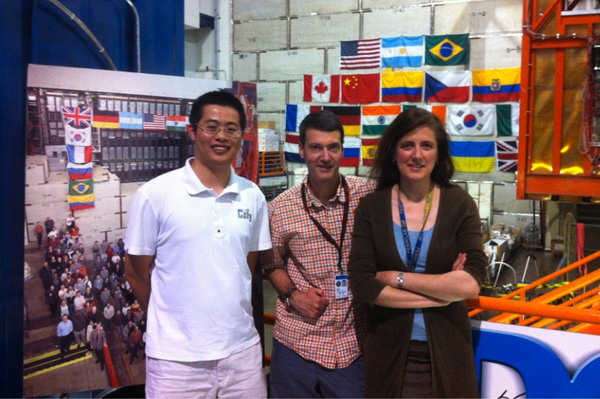A pivotal moment for particle physics

A search that began almost 50 years ago is finally coming to a close. “But this is just the beginning,” said Northeastern physics professor Emanuela Barberis.
She and her Northeastern colleagues Darien Wood and George Alverson have been among thousands of physicists in search of the Higgs Boson with the DZero experiment at Fermilab in Illinois and the CMS experiment at CERN in Switzerland. Earlier this week, physicists at CERN announced the most definitive evidence yet.
The so-called “God particle” was first theorized in the 1960s as essential to the Standard Model of particle physics. Without it, our fundamental understanding of the universe would be incorrect and some other explanation would be necessary.
The Standard Model says that fundamental particles in our universe attain mass by passing through a “Higgs field,” which is similar to an electromagnetic field but with one key difference. Instead of generating electromagnetic radiation, a Higgs field generates mass.
“When the field is interacting with itself, you get the Higgs boson,” said Barberis. “If the field is there, you should observe this particle.”
But the Higgs is one of the heaviest fundamental particles around; as such, it is very unstable and readily decays into lighter particles, like electrons, muons and photons. In explaining why it took so long for physicists to finally see evidence of the particle’s existence, Barberis explained that the probability of producing it is very small.
The researchers’ challenge was augmented by the fact that observing the fundamental building blocks of the universe is no easy task. Scientists collide subatomic particles, like protons, into one another at a rate near the speed of light. The resulting debris consists of a mess of elementary particles, each of whose mass is detected and measured against a background of known particle masses. Any unusual signals could be a sign of a previously unobserved particle — like the Higgs.
Because mass can be correlated to energy, higher energy collisions will generate particles of higher mass. Since the 1990s, when the first Higgs search began in earnest, scientists have created colliders of greater and greater energy, ruling out potential Higgs masses and narrowing down the window in which it could be found.
Fermilab’s Tevatron produced collisions with energies up to two teraelectronvolts (or two trillion electronvolts) while CERN’s Large Hadron Collider can currently reach eight teraelectronvolts.
On Monday, Fermilab scientists announced that the Higgs boson would have a mass between 115 and 135 gigaelectronvolts. Then, on Wednesday, CERN’s team enhanced that prediction by presenting spectacular signals of a new particle with a mass around 125 gigalectronvolts. The probability that the CERN signal is a fluke is one in three million. But there’s still a possibility that it is not the Higgs at all.
Going forward, CERN’s Large Hadron Collider will continue colliding protons with one another and sifting through the resulting fragments in an effort to better understand the Higgs and all the other particles we know of — and perhaps some that we don’t.
“This is a pivotal event that will help us shape the future of particle physics research,” said Barberis. “Scientists will now focus on understanding the properties of the observed particle through its interactions with other particles.”





